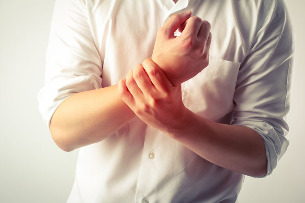Osteochondrosis is a disease that is one of the most widespread in the world. Most people after the age of 35 have osteochondrosis of the cervical spine in one form or another. Recently there has been a trend to the increase in the number of persons suffering from a severe form of the disease and rejuvenation of the disease, to reduce its lower age, the threshold. This is due to the fact that a growing number of people in the world and work sitting and leading a sedentary life. Meanwhile, the disease is quite dangerous, and everyone should know, what is the pain in the lower back, such that it manifests itself and how is it treated, to be able to recognize symptoms in a timely manner and begin treatment.

The reasons of occurrence of cervical osteoarthritis
Low back pain is one of the few diseases that are characterized by one person. In other animals, this disease does not occur. It is because of this peculiarity of man, as standing. The vertical position of the spine means that the vertebrae sit one on top of the other and musculoskeletal cartilage, the tissue of the spine degrades gradually and deforms. The vertebral column of man begins with the cervical spine. In this department of seven vertebrae from the first to the seventh. The vertebrae are separated from each other intervertebral disks. The cervical spine is particularly vulnerable to a party who is related in the first place, with the increase of the mobility of the vertebrae in this area. In the cervical region of the disease is reflected, above all, on the discs, which are a weak point in the structure of the spine. The prevalence of cervical osteoarthritis, also contribute to such factors as the small size of the vertebrae and the relative weakness of the muscles of the neck. Also on the development of cervical osteoarthritis great influence of the failure of vascularization of the cartilage. Therefore, the development of the disease is a long and complex process and has not a single reason. Although the communication is established between a sedentary job, the man, and by the presence of cervical osteoarthritis, however, the disease is often encountered in subjects trained people, especially athletes due to the increased load on the cervical spine when you are lifting weights. In the elderly, generally, the deterioration of vertebral structures is an inevitable process, linked to the ageing of the body and the weakening of its defenses. However, more often pathological type of cervical osteoarthritis, which play an important role in internal or external negative factors.
The factors contributing to the development of degenerative disc disease of the neck:
- The violation of posture
- The curvature of the spine
- A back injury
- Excess weight
- Physical work, heavy
- A sedentary job
- A sedentary lifestyle
- Violation of the metabolic processes
- Frequent hypothermia
- Drawback of the posture during sleep
- The stress, the burnout is
- Hereditary factors
- Infectious diseases
- The individual characteristics of the structure of the body, for example, too long or too short neck
The degree of development of cervical osteoarthritis
The disease has four stages. It is not always easy to determine the stage of the disease on the analysis of the symptoms, as is sometimes the degree of degradation of the osteo-cartilaginous may not correspond to the symptoms observed in the patient.

The first degree
Begin the process of osteo-cartilaginous vertebrae. Generally, at this stage of the degenerative disc disease cervical symptoms are mild. Patients or not notice them at all, or is not associated with the diseases of the spinal column, and attribute it to stress and fatigue.
The second degree of the
Starts a decrease of the height of the disk, on the surface cracks appear. The symptoms of cervical arthritis at this stage are manifest in pain, weakness, numbness of the individual sections of the person.
The third degree
Formed, herniated discs, damaged scarves the blood vessels and muscles. The patient appears dizziness, pain in the part occipital of the head.
The fourth degree
Appear osteophytes – proliferation in the bone tissue, to protect the vertebrae of the load, which leads to the achievement of the nerves are. This leads to the stiffness of the movements and damage neighboring joints.
Osteochondrosis cervical spondylosis: signs and symptoms
The main symptoms of osteoarthritis of the cervical spine:
- A pain in the neck and shoulders
- The weakness of the muscles
- The increased sweating
- Numbness in the hands
- Disorders of coordination
- Vertigo
- The deterioration of vision and hearing
- The Increase of the blood pressure
- Headaches
These are typical of the degenerative disc disease of the cervical spine symptoms can be present at all stages of the disease. In most cases, there are few symptoms from the list, and the rest can be away from the Man, for the first time confronted with the likes of the symptoms of the disease is not always suspected of himself osteochondrosis cervical. Therefore, it can appeal to different doctors and therapists, cardiologists, neurologists, surgeons. And a good diagnosis can be made with a significant delay.

Syndromes
When osteochondrosis cervical occurs several syndromes, it is typical of states with a complex of characteristic signs. They are a function of the nerves and arteries unite their efforts are affected by a disease:
- the syndrome of the vertebral artery
- heart syndrome
- hypertensive syndrome
- radicular syndrome
- the syndrome of migraine cervical
The syndrome of the vertebral artery – one of the most unpleasant and dangerous complications of osteochondrosis cervical. It is due to the fact that reduces the blood flow in the artery, and, passing along the spinal column and of the power of the brain. The syndrome is manifested in such symptoms, as the system or periodic dizziness, loss of hearing and sight. In some cases, there may be fainting. Often, there is a variant of the syndrome, bearing in that in the normal state of the blood flow in the artery is normal, but during the rotation of the head in one direction or another, it can drop dramatically. Heart, syndrome develops when the pressure of the roots of the nerves are, exercising tadalafil is a diaphragm or muscle of the chest. As a result, the patient can have pain like the cardialgia, although the direct effects on the heart is not the case. However, the syndrome can be characterized by phenomena such as tachycardia, hypotension and arrhythmia. Hypertension, the syndrome also applies to the number of more dangerous complications. In contrast to the syndrome of the vertebral artery, it is called compression, not to the board of trustees of the arteries and veins, which makes difficult the flow of blood to the head. The syndrome leads to an increase of the intracranial pressure, which can be manifested by symptoms such as nausea, vomiting, headache. The syndrome of the neck of the migraine has little to do with their etiology of classic migraine. It is manifested in more severe pain in the part occipital of the head. The pain a bad sign, the character, paroxysmal, lasting up to ten hours and are accompanied by vomiting. Radicular syndrome the most common syndrome, osteochondrosis cervical. Called to the compression of individual nerve roots in the cervical vertebrae. It can express pain in the region of the neck, nape, shoulder blades, shoulders, in numbness and weakness of the tone of the individual sections of the hand (up to the impossibility to perform a sort of manipulation) and of the neck. Very often, can be observed in several syndromes, or whether the characteristic symptoms of different syndromes. As can be seen, osteochondrosis of the cervical spine manifestations of the disease are multiple and not always for the patient is able to correctly recognize in him the cause of their appearance. If you are experiencing similar symptoms, it is a reason to go to the doctor.

The diagnosis
For the diagnosis, it is recommended to consult a therapist. It gives the direction to the expert, orthopedic surgeon, the spine, a neurologist. For the diagnosis, the following types of research:
- X-ray
- Ct
- Magnetic tomography
- Ultrasound of the vessels of the neck
X-ray can determine the offset of the vertebrae, the presence of outgrowths – osteophytes and calcification, joints and discs. The computed tomography is to create a series of x-rays, giving large representation to the authority, in this case on the cervical spine. It gives detail to the level of a pathological process – nature of the compression of the nerves are to, the structure of the osteophytes, the height of disks, etc., in magnetic resonance tomography, based on the physical effect of nuclear magnetic resonance, gives even more structural of the image of the spine. ULTRASOUND of the vessels of the neck allows you to identify the changes in blood flow in the major vessels of the neck, caused by a disease.
The treatment of cervical osteoarthritis at home
How to treat osteochondrosis cervical to the home and is treated there in general? The fight against the disease of the medicine has developed many methods. Some methods of processing can be applied at home. But this process is long and the complete cure is unlikely, especially in old age. However slow down and stop the destructive processes of the spine may be at any stage of the disease. In the initial stages of the disease methods generally conservative in nature. For the treatment of cervical osteoarthritis are used in several ways:
- Drugs
- Physiotherapy
- Physiotherapy
- Massage
- Special funds for the fixation of the spine
If the disease has moved in the last phase, and severe destruction of bone-cartilage structure of the spine, and then, for the treatment of degenerative disc disease of the cervical spine may be applied, and rapid response.
Drugs
The types of preparations:
- Chondroprotectors
- Vitamins
- Analgesics
- Anti-inflammatory
- Antispasmodic

During the acute phase the pain syndrome related to osteochondrosis, it is essential to remedy the situation. Usually use oral medications, such as Analgin or Baralgin, but their ineffectiveness in severe cases is used novocaine blockade. When the muscle spasms apply antispasmodic. The greater efficacy of osteochondrosis demonstrates created against this disease medicine, much as possible, and the use of other muscle relaxants. As an anti-inflammatory and analgesic, you can use ointments containing drugs non-steroidal. In the presence of syndromes related to a violation of the blood circulation and the cerebral circulation – hypertension and the syndrome of the vertebral artery, are drugs that are adverse effects of these syndromes – funds, lowering the pressure and smart drugs of the tool.
Physiotherapy
Physiotherapy is the most simple and affordable with a view the treatment of cervical osteoarthritis and, at the same time, quite effective. The processing of the exercise, you can move on to the house. Osteochondrosis of the intensity of the training does not play a decisive role only in need of their regularity. In the first place, physical fitness is designed to strengthen the muscles of the neck, to compensate for the lack of functionality of the spine and allow him to keep the weakening of the vertebrae. To strengthen the muscles of the neck are recommended daily activities. They can be very simple, consisting of the twists and turns and slopes of the head from all sides, and more complex, including using cervical muscles of the hand of the hand. You can do at home and at work. For example, if the work is sedentary, it is useful to do these exercises after the hour to sit behind a table or a monitor. However, the program may be outside the period of exacerbation of the disease and the absence of pain. In the contrary case, they are only able to worsen. Not less effective and the strengthening of the muscles of the shoulder girdle, for example, using a regular practice with dumbbells. However, lifting weights (dumbbells, bars) is contraindicated. Useful also regularly during swimming, unloading of the spine.
Physiotherapy
Physiotherapy is a treatment method that uses effects on the body some of the physical fields and radiation. Positive property of the physiotherapy, it is that it has a minimum of contraindications. For the treatment of degenerative disc disease following apply techniques of physiotherapy:
- Ultrasound examination of the impact
- Laser therapy
- The effects of a magnetic field
- The effects of electric current (electrophoresis)
The magnetic field has a positive effect on the damaged tissues of the body and has anti-inflammatory and analgesic effect. Ultrasound improves tissue metabolism, relieves swelling. It is the same on the laser treatment. Electrophoresis is most often used in conjunction with medication, such as the application of an electrical current accelerates their assimilation by the body.

Massage
The massage reduces the increased tone of muscles causing a spasm, and reduces the flow of lymph, causing swelling. The procedure contributes to the improvement of the blood circulation in the affected area, and that stops the process of destruction of intervertebral disc.
Other methods of treatment
What to do when the cervical spine osteochondrosis, if the conventional methods of home treatment doesn't help? To reduce the load on cervical applies a special device – neck Ditch, which enters the neck constantly to the normal position. Its it is recommended to wear during the aggravations if the pain syndrome or long-term sedentary work. In order to avoid aggravations, it is also appropriate to arrange a place to sleep. The cushion should not cause the curvature of the nape of the neck, and the mattress must be hard and smooth. In some cases, can help a special equipment for the sleep – orthopedic mattresses and a pillow.

































